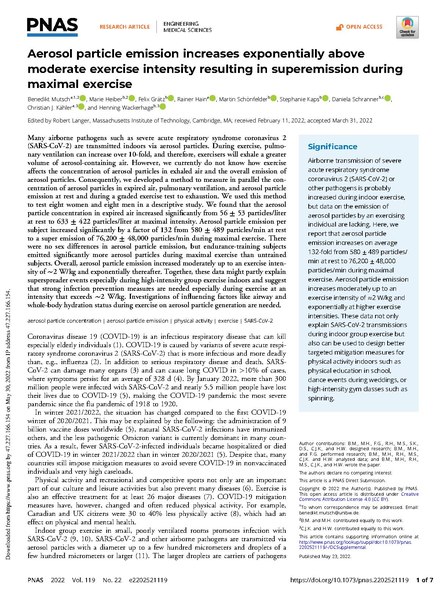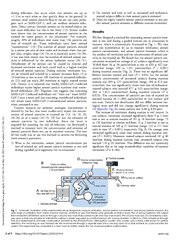File:Aerosol particle emission increases exponentially above moderate exercise intensity resulting in superemission during maximal exercise.pdf

Original file (1,216 × 1,629 pixels, file size: 1 MB, MIME type: application/pdf, 7 pages)
Captions
Captions
Summary[edit]
| DescriptionAerosol particle emission increases exponentially above moderate exercise intensity resulting in superemission during maximal exercise.pdf |
English: Significance
Airborne transmission of severe acute respiratory syndrome coronavirus 2 (SARS-CoV-2) or other pathogens is probably increased during indoor exercise, but data on the emission of aerosol particles by an exercising individual are lacking. Here, we report that aerosol particle emission increases on average 132-fold from 580 ± 489 particles/min at rest to 76,200 ± 48,000 particles/min during maximal exercise. Aerosol particle emission increases moderately up to an exercise intensity of ≈2 W/kg and exponentially at higher exercise intensities. These data not only explain SARS-CoV-2 transmissions during indoor group exercise but also can be used to design better targeted mitigation measures for physical activity indoors such as physical education in school, dance events during weddings, or high-intensity gym classes such as spinning. Abstract Many airborne pathogens such as severe acute respiratory syndrome coronavirus 2 (SARS-CoV-2) are transmitted indoors via aerosol particles. During exercise, pulmonary ventilation can increase over 10-fold, and therefore, exercisers will exhale a greater volume of aerosol-containing air. However, we currently do not know how exercise affects the concentration of aerosol particles in exhaled air and the overall emission of aerosol particles. Consequently, we developed a method to measure in parallel the concentration of aerosol particles in expired air, pulmonary ventilation, and aerosol particle emission at rest and during a graded exercise test to exhaustion. We used this method to test eight women and eight men in a descriptive study. We found that the aerosol particle concentration in expired air increased significantly from 56 ± 53 particles/liter at rest to 633 ± 422 particles/liter at maximal intensity. Aerosol particle emission per subject increased significantly by a factor of 132 from 580 ± 489 particles/min at rest to a super emission of 76,200 ± 48,000 particles/min during maximal exercise. There were no sex differences in aerosol particle emission, but endurance-training subjects emitted significantly more aerosol particles during maximal exercise than untrained subjects. Overall, aerosol particle emission increased moderately up to an exercise intensity of ∼2 W/kg and exponentially thereafter. Together, these data might partly explain superspreader events especially during high-intensity group exercise indoors and suggest that strong infection prevention measures are needed especially during exercise at an intensity that exceeds ∼2 W/kg. Investigations of influencing factors like airway and whole-body hydration status during exercise on aerosol particle generation are needed. |
| Date | |
| Source | https://www.pnas.org/doi/full/10.1073/pnas.2202521119 |
| Author | Benedikt Mutsch https://orcid.org/0000-0001-5041-0284 benedikt.mutsch@unibw.de, Marie Heiber https://orcid.org/0000-0002-9224-6029, Felix Grätz https://orcid.org/0000-0002-6457-9280, +5, Rainer Hain https://orcid.org/0000-0003-2614-5374, Martin Schönfelder https://orcid.org/0000-0002-3003-3378, Stephanie Kaps https://orcid.org/0000-0002-7436-8022, Daniela Schranner https://orcid.org/0000-0003-2316-318X, Christian J. Kähler https://orcid.org/0000-0001-9336-2091, and Henning Wackerhage https://orcid.org/0000-0001-5920-5842 |
Licensing[edit]
- You are free:
- to share – to copy, distribute and transmit the work
- to remix – to adapt the work
- Under the following conditions:
- attribution – You must give appropriate credit, provide a link to the license, and indicate if changes were made. You may do so in any reasonable manner, but not in any way that suggests the licensor endorses you or your use.
File history
Click on a date/time to view the file as it appeared at that time.
| Date/Time | Thumbnail | Dimensions | User | Comment | |
|---|---|---|---|---|---|
| current | 22:44, 30 May 2022 |  | 1,216 × 1,629, 7 pages (1 MB) | Koavf (talk | contribs) | Uploaded a work by Benedikt Mutsch https://orcid.org/0000-0001-5041-0284 benedikt.mutsch@unibw.de, Marie Heiber https://orcid.org/0000-0002-9224-6029, Felix Grätz https://orcid.org/0000-0002-6457-9280, +5, Rainer Hain https://orcid.org/0000-0003-2614-5374, Martin Schönfelder https://orcid.org/0000-0002-3003-3378, Stephanie Kaps https://orcid.org/0000-0002-7436-8022, Daniela Schranner https://orcid.org/0000-0003-2316-318X, Christian J. Kähler https://orcid.org/0000-0001-9336-2091, and Henning... |
You cannot overwrite this file.
File usage on Commons
The following page uses this file:
Metadata
This file contains additional information such as Exif metadata which may have been added by the digital camera, scanner, or software program used to create or digitize it. If the file has been modified from its original state, some details such as the timestamp may not fully reflect those of the original file. The timestamp is only as accurate as the clock in the camera, and it may be completely wrong.
| Short title |
|
|---|---|
| Image title | Proc. Natl. Acad. Sci. U.S.A. 2022.119:e2202521119 |
| Software used | PTC Arbortext Advanced Print Publisher 11.1.4012/W |
| Date and time of digitizing | 20:07, 20 May 2022 |
| File change date and time | 08:39, 30 May 2022 |
| Date metadata was last modified | 08:39, 30 May 2022 |
| Conversion program | Adobe LiveCycle PDF Generator; modified using iText 4.2.0 by 1T3XT |
| Encrypted | no |
| Page size | 584.957 x 782.986 pts |
| Version of PDF format | 1.4 |
